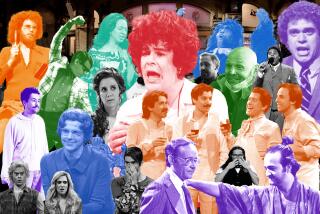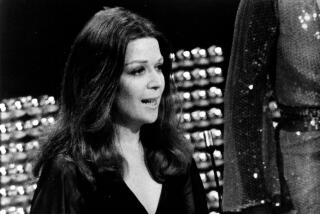Stage : ‘Together Again’ Conjures Up More Than Nostalgia
There’s no denying that “Together Again” has set sail at the Westwood Playhouse on a dependably strong wind of nostalgia for the early days of television, when Sid Caesar and Imogene Coca (along with Carl Reiner and Howie Morris) starred in “Your Show of Shows,” one of the most cripplingly funny programs in TV history.
(In tandem with “The Jackie Gleason Show,” it made Saturday night in New York the bane of Broadway theater because no one wanted to go out.)
“Together Again” is Caesar and Coca’s stage distillation of some of the best of the “Your Show of Shows” segments and, fortunately, they don’t have to rely altogether on nostalgia’s charitably pink spot. It’s enormously difficult to make a television show work in the theater (as it is the other way around), and it’s difficult as well to generate humor that can leap across generations. But there are a number of ways to enjoy this show, particularly in contrast to the recycled dead air that most TV comedy generates these days.
For one thing, the energy and techniques that drove “Your Show of Shows”--and by extension this one--were basically theatrical. The currents of vaudeville, the music hall, legit variety shows, Yiddish theater and even early burlesque were still alive in the writing and performances of “Your Show of Shows.” The performers knew how to play characters and sketches.
They understood how to read the nuances of an audience the way a surfer reads the burgeoning shape of a wave, so that they could catch a ride on a theatrical moment. They knew how to sustain a sketch because they’d grown up in an era before the technique of video splicing and cutting had made prolonged concentration irrelevant.
That’s why Caesar and Coca can play out the majority of their sketches the way good jazz musicians take up a theme and shake it out from every angle, such as the “At the Movies” segment, in which (as strangers) she fidgets and he quietly frets, and her argument with her hot-tempered boyfriend results in Caesar literally losing his shirt.
Too, there is the variety of material. Each sketch is distinctly unlike any other, whether it proceeds from a fairly ordinary premise, like what a bridegroom thinks as he walks down the aisle, or an imaginative one, like what a penny gum-ball machine feels and thinks (Mel Brooks, who wrote for “Your Show of Shows,” recalls that Caesar would drive his writers crazy with his wacky premises, such as his insistence one day that they work up a routine based on the thoughts of a housefly). One of the genuine treats of “Your Show of Shows” is that you never knew what they were going to try next.
Then, there’s the physical expressiveness of the performers themselves. Coca always had a great catch-all face for comedy; it didn’t miss a trick, and her mugging was (and is) nicely counterpoised against a shrewd, Dorothy Parker-like flintiness, particularly when she strikes her object of suspicion with a one-eyed, piratical glare.
Caesar uses himself well too. He can be broad, as when his shy young boy at a dance can’t keep his hysterically paralyzed tongue from flopping out of his mouth, and he can be subtle--making his way across a row of seats at the movies, he stops cold and stares out with an absolute deadpan stillness to convey the unmistakable sensation of having been goosed. And, of course, his gift for improvising accents is as remarkable as ever.
At ages 69 and 82 respectively, Caesar and Coca aren’t quite up to the demands of their more knockabout moments--Coca visibly tired opening night at the expense of a couple of later sketches, and Caesar moved with caution (he’s had relatively recent leg surgery). Too, the great energy and invention that always informed Caesar’s routines (he’s onstage a lot more then she is) have been the very things that keep him from knowing when to stop. He’s a highly repetitive comedian--you usually get what he’s going after right away; the ingenuity of his routines is always at war with his ostinatos .
That may be why, after intermission, the show begins to flag, until Professor Ludwig von Knowitall comes to the rescue with his abstruse theory of Is and Now, and how bad nows make lousy wases (or “vuzzes”).
One can make the case that “Together Again” is corny and dated, but that would be like criticizing Dickens for writing like a Victorian. America was a different place in the early ‘50s, more innocent, or at least more naive, and it would be preposterous and unworkable to try to refashion “Together Again” in the snide atmosphere of the postmodern put-down.
Caesar and Coca have succeeded in what they set out to do, by giving us a feel for how one of the greatest chapters in American comedy history was played out.
What’s just as rewarding and even surprising is how, in the twilight of their careers, the frazzle of comedy has given way to a capacity to charm. They were very much in the present when they took their curtain call.
‘Together Again’
With Sid Caesar, Imogene Coca and Lee Delano. Music by Rolfe Barnes and Orchestra. Producers Michael Frazier, Eric Krebs. Original producer Larry Spellman. Lights Terry Jackson. Sound Jon Sound. Wardrobe Nancy Endy. Stage manager Sam Burgess. Assistant stage manager Kent Barnes.
More to Read
The biggest entertainment stories
Get our big stories about Hollywood, film, television, music, arts, culture and more right in your inbox as soon as they publish.
You may occasionally receive promotional content from the Los Angeles Times.










